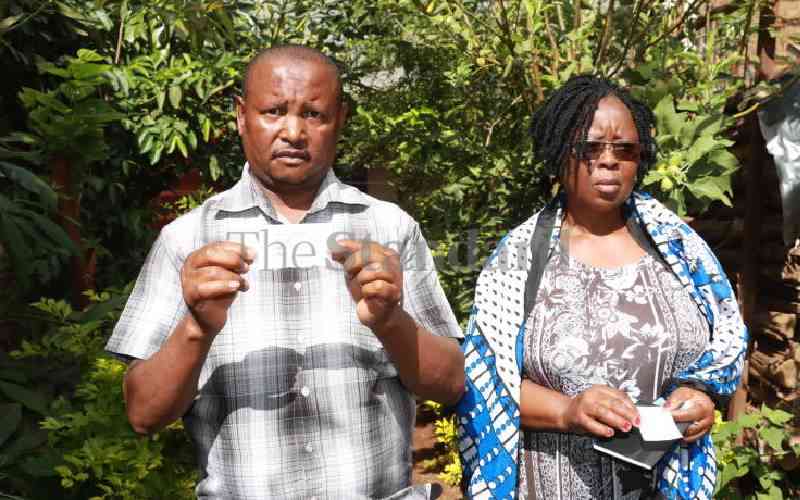By Standard on Saturday Team
 |
|
The casket carrying remains of former Internal Security Minister George Saitoti.[Photos:File] |
NAIROBI, KENYA: An investigation into the helicopter crash that killed former Cabinet minister George Saitoti and five others details a series of factors that doomed the flight.
The aircraft was overloaded by 11 kilograms, which hampered controls, a commission of inquiry into the air crash led by judge Kalpana Rawal found. It was also flying in bad weather with two pilots who were not trained to fly in poor visibility at the controls. As a result, “loss of situational awareness” is listed as the probable cause of the crash. However, questions remain.
The report raises the mystery of excessive carbon monoxide in the body of a co-pilot, Captain Luke Oyugi. The commission said available evidence ruled out an inflight fire as the source of the harmful gas. It attributes the failure to resolve the carbon monoxide puzzle to shoddy pathological and toxicological investigation reports. The Government pathologist’s final report on the cause of deaths did not consider toxicology reports. This is because the Government Chemist did not share the findings of the toxicology tests with the pathologist. The report does not explain why this was the case.
Another answered puzzle is why the commission did not verify the veracity of claims the National Intelligence Service interfered with forensic findings. While testifying in October, a witness, Dr Amriptal Kalsi, alleged her boss said the NIS instructed that forensic findings be kept secret.
Postmortem examinations
Dr Kalsi claimed her supervisor, Dr Johanssen Oduor, said the agency called him a day after postmortem examinations directing that photographs and notes taken during the tests at Lee Funeral Home, Nairobi “must not be shared with anybody”. Dr Oduor, who had testified earlier, had not made reference to the NIS. He was not called back to respond to this claim. The report, which was presented to then President Kibaki in February, but made public yesterday, has no reference to the NIS either, suggesting the commissioners dismissed the evidence as hearsay. But it raises the question why that conclusion was reached without recalling Dr Oduor to the stand to test the claims. The commission concluded bad weather, inexperience by the pilots to fly in the adverse conditions, excess weight and poor safety standards by the Kenya Police Air Wing are factors that combined to cause the crash.
“The probable cause of the accident was loss of aircraft control due to loss of situational awareness, attributable to continuation of flight into Instrument Meteorological Conditions for which the crew were not qualified. This resulted in crew disorientation,” the report concludes.
The report notes the two pilots were licensed to operate helicopter without Instrument Rating hence did not have requisite skills to fly in IMC conditions.
“The loss of control was made worse by high gross weight conditions and the centre of gravity being at the edge of the safe limit,” says the report, adding the situation was worsened by the poor safety culture of police air wing.
Investigations found out the aircraft were overweight by at least 11kgs based on conservative weight figures of 80kg per passenger used in the load sheet by the KPAW. The weight of the six occupants is estimated at 2,261 kg. The maximum certificated takeoff weight is 2,250.3kg.
Official records on the flight, which was airborne for just over ten minutes, also indicate that there was more weight on the left-hand side of the chopper, likely because the heavier passengers chose to sit on the same side. The uneven weight distribution complicated the balance of the France-built Eurocopter chopper as it took off from Wilson Airport. Another curious finding is that investigators and Government Chemist involved in the postmortem analysis inexplicably left out carbon monoxide results for some of the people in the aircraft.
 The Standard Group Plc is a
multi-media organization with investments in media platforms spanning newspaper
print operations, television, radio broadcasting, digital and online services. The
Standard Group is recognized as a leading multi-media house in Kenya with a key
influence in matters of national and international interest.
The Standard Group Plc is a
multi-media organization with investments in media platforms spanning newspaper
print operations, television, radio broadcasting, digital and online services. The
Standard Group is recognized as a leading multi-media house in Kenya with a key
influence in matters of national and international interest.
 The Standard Group Plc is a
multi-media organization with investments in media platforms spanning newspaper
print operations, television, radio broadcasting, digital and online services. The
Standard Group is recognized as a leading multi-media house in Kenya with a key
influence in matters of national and international interest.
The Standard Group Plc is a
multi-media organization with investments in media platforms spanning newspaper
print operations, television, radio broadcasting, digital and online services. The
Standard Group is recognized as a leading multi-media house in Kenya with a key
influence in matters of national and international interest.






